Lukas Lange
A Solver-in-the-Loop Framework for Improving LLMs on Answer Set Programming for Logic Puzzle Solving
Dec 18, 2025



Abstract:The rise of large language models (LLMs) has sparked interest in coding assistants. While general-purpose programming languages are well supported, generating code for domain-specific languages remains a challenging problem for LLMs. In this paper, we focus on the LLM-based generation of code for Answer Set Programming (ASP), a particularly effective approach for finding solutions to combinatorial search problems. The effectiveness of LLMs in ASP code generation is currently hindered by the limited number of examples seen during their initial pre-training phase. In this paper, we introduce a novel ASP-solver-in-the-loop approach for solver-guided instruction-tuning of LLMs to addressing the highly complex semantic parsing task inherent in ASP code generation. Our method only requires problem specifications in natural language and their solutions. Specifically, we sample ASP statements for program continuations from LLMs for unriddling logic puzzles. Leveraging the special property of declarative ASP programming that partial encodings increasingly narrow down the solution space, we categorize them into chosen and rejected instances based on solver feedback. We then apply supervised fine-tuning to train LLMs on the curated data and further improve robustness using a solver-guided search that includes best-of-N sampling. Our experiments demonstrate consistent improvements in two distinct prompting settings on two datasets.
Language Mixing in Reasoning Language Models: Patterns, Impact, and Internal Causes
May 20, 2025Abstract:Reasoning language models (RLMs) excel at complex tasks by leveraging a chain-of-thought process to generate structured intermediate steps. However, language mixing, i.e., reasoning steps containing tokens from languages other than the prompt, has been observed in their outputs and shown to affect performance, though its impact remains debated. We present the first systematic study of language mixing in RLMs, examining its patterns, impact, and internal causes across 15 languages, 7 task difficulty levels, and 18 subject areas, and show how all three factors influence language mixing. Moreover, we demonstrate that the choice of reasoning language significantly affects performance: forcing models to reason in Latin or Han scripts via constrained decoding notably improves accuracy. Finally, we show that the script composition of reasoning traces closely aligns with that of the model's internal representations, indicating that language mixing reflects latent processing preferences in RLMs. Our findings provide actionable insights for optimizing multilingual reasoning and open new directions for controlling reasoning languages to build more interpretable and adaptable RLMs.
Lost in Multilinguality: Dissecting Cross-lingual Factual Inconsistency in Transformer Language Models
Apr 05, 2025



Abstract:Multilingual language models (MLMs) store factual knowledge across languages but often struggle to provide consistent responses to semantically equivalent prompts in different languages. While previous studies point out this cross-lingual inconsistency issue, the underlying causes remain unexplored. In this work, we use mechanistic interpretability methods to investigate cross-lingual inconsistencies in MLMs. We find that MLMs encode knowledge in a language-independent concept space through most layers, and only transition to language-specific spaces in the final layers. Failures during the language transition often result in incorrect predictions in the target language, even when the answers are correct in other languages. To mitigate this inconsistency issue, we propose a linear shortcut method that bypasses computations in the final layers, enhancing both prediction accuracy and cross-lingual consistency. Our findings shed light on the internal mechanisms of MLMs and provide a lightweight, effective strategy for producing more consistent factual outputs.
Bring Your Own Knowledge: A Survey of Methods for LLM Knowledge Expansion
Feb 18, 2025Abstract:Adapting large language models (LLMs) to new and diverse knowledge is essential for their lasting effectiveness in real-world applications. This survey provides an overview of state-of-the-art methods for expanding the knowledge of LLMs, focusing on integrating various knowledge types, including factual information, domain expertise, language proficiency, and user preferences. We explore techniques, such as continual learning, model editing, and retrieval-based explicit adaptation, while discussing challenges like knowledge consistency and scalability. Designed as a guide for researchers and practitioners, this survey sheds light on opportunities for advancing LLMs as adaptable and robust knowledge systems.
QUITE: Quantifying Uncertainty in Natural Language Text in Bayesian Reasoning Scenarios
Oct 14, 2024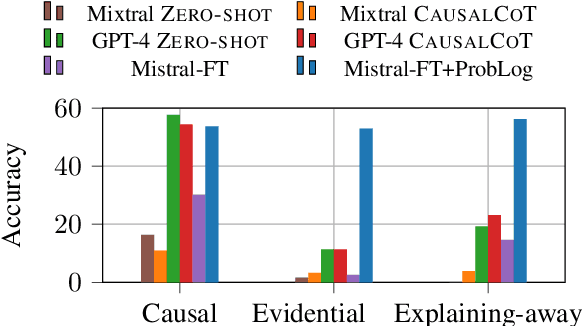
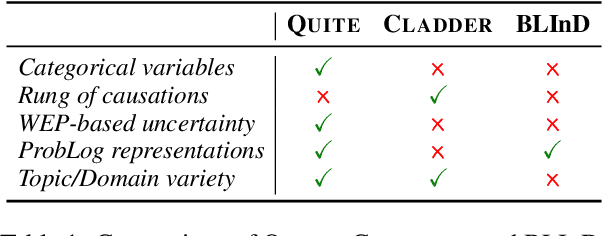
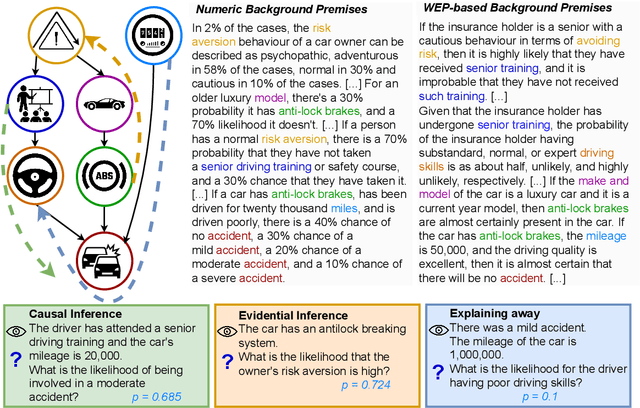
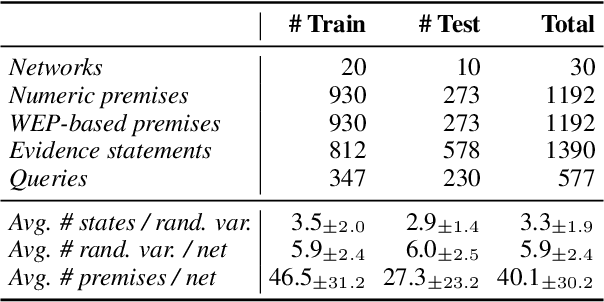
Abstract:Reasoning is key to many decision making processes. It requires consolidating a set of rule-like premises that are often associated with degrees of uncertainty and observations to draw conclusions. In this work, we address both the case where premises are specified as numeric probabilistic rules and situations in which humans state their estimates using words expressing degrees of certainty. Existing probabilistic reasoning datasets simplify the task, e.g., by requiring the model to only rank textual alternatives, by including only binary random variables, or by making use of a limited set of templates that result in less varied text. In this work, we present QUITE, a question answering dataset of real-world Bayesian reasoning scenarios with categorical random variables and complex relationships. QUITE provides high-quality natural language verbalizations of premises together with evidence statements and expects the answer to a question in the form of an estimated probability. We conduct an extensive set of experiments, finding that logic-based models outperform out-of-the-box large language models on all reasoning types (causal, evidential, and explaining-away). Our results provide evidence that neuro-symbolic models are a promising direction for improving complex reasoning. We release QUITE and code for training and experiments on Github.
Better Call SAUL: Fluent and Consistent Language Model Editing with Generation Regularization
Oct 03, 2024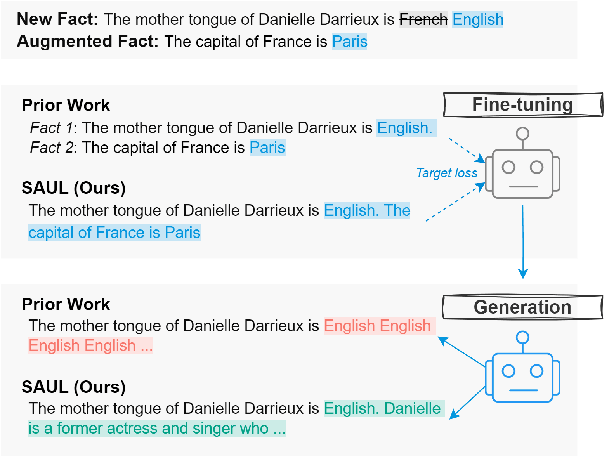
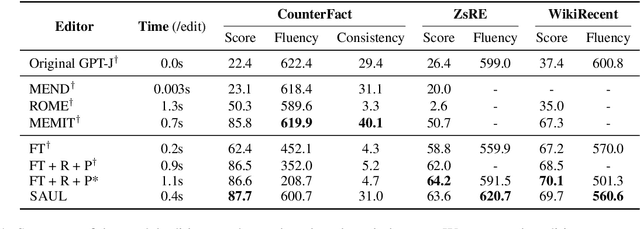
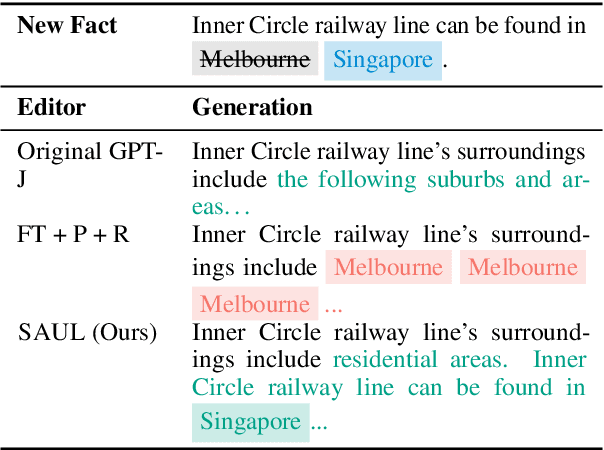
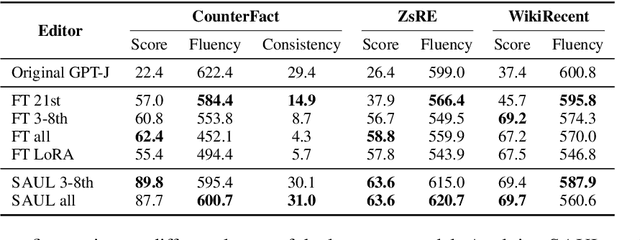
Abstract:To ensure large language models contain up-to-date knowledge, they need to be updated regularly. However, model editing is challenging as it might also affect knowledge that is unrelated to the new data. State-of-the-art methods identify parameters associated with specific knowledge and then modify them via direct weight updates. However, these locate-and-edit methods suffer from heavy computational overhead and lack theoretical validation. In contrast, directly fine-tuning the model on requested edits affects the model's behavior on unrelated knowledge, and significantly damages the model's generation fluency and consistency. To address these challenges, we propose SAUL, a streamlined model editing method that uses sentence concatenation with augmented random facts for generation regularization. Evaluations on three model editing benchmarks show that SAUL is a practical and reliable solution for model editing outperforming state-of-the-art methods while maintaining generation quality and reducing computational overhead.
Learn it or Leave it: Module Composition and Pruning for Continual Learning
Jun 26, 2024

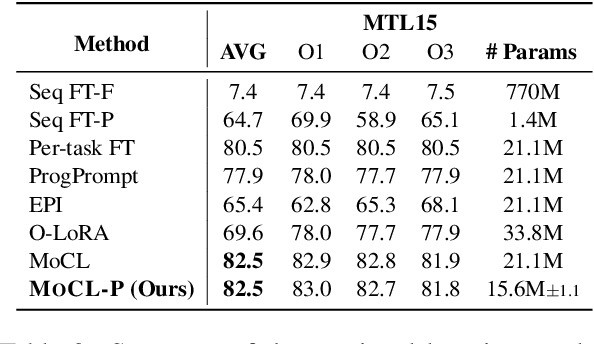
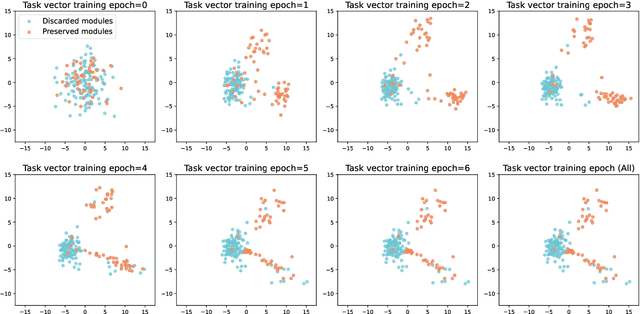
Abstract:In real-world environments, continual learning is essential for machine learning models, as they need to acquire new knowledge incrementally without forgetting what they have already learned. While pretrained language models have shown impressive capabilities on various static tasks, applying them to continual learning poses significant challenges, including avoiding catastrophic forgetting, facilitating knowledge transfer, and maintaining parameter efficiency. In this paper, we introduce MoCL-P, a novel lightweight continual learning method that addresses these challenges simultaneously. Unlike traditional approaches that continuously expand parameters for newly arriving tasks, MoCL-P integrates task representation-guided module composition with adaptive pruning, effectively balancing knowledge integration and computational overhead. Our evaluation across three continual learning benchmarks with up to 176 tasks shows that MoCL-P achieves state-of-the-art performance and improves parameter efficiency by up to three times, demonstrating its potential for practical applications where resource requirements are constrained.
AnnoCTR: A Dataset for Detecting and Linking Entities, Tactics, and Techniques in Cyber Threat Reports
Apr 11, 2024



Abstract:Monitoring the threat landscape to be aware of actual or potential attacks is of utmost importance to cybersecurity professionals. Information about cyber threats is typically distributed using natural language reports. Natural language processing can help with managing this large amount of unstructured information, yet to date, the topic has received little attention. With this paper, we present AnnoCTR, a new CC-BY-SA-licensed dataset of cyber threat reports. The reports have been annotated by a domain expert with named entities, temporal expressions, and cybersecurity-specific concepts including implicitly mentioned techniques and tactics. Entities and concepts are linked to Wikipedia and the MITRE ATT&CK knowledge base, the most widely-used taxonomy for classifying types of attacks. Prior datasets linking to MITRE ATT&CK either provide a single label per document or annotate sentences out-of-context; our dataset annotates entire documents in a much finer-grained way. In an experimental study, we model the annotations of our dataset using state-of-the-art neural models. In our few-shot scenario, we find that for identifying the MITRE ATT&CK concepts that are mentioned explicitly or implicitly in a text, concept descriptions from MITRE ATT&CK are an effective source for training data augmentation.
Discourse-Aware In-Context Learning for Temporal Expression Normalization
Apr 11, 2024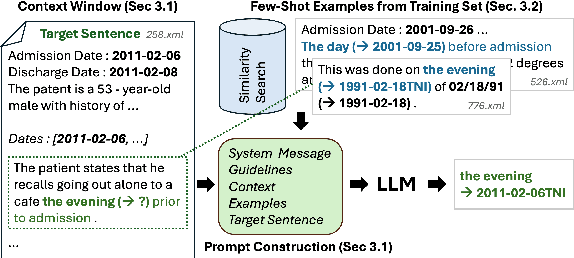



Abstract:Temporal expression (TE) normalization is a well-studied problem. However, the predominately used rule-based systems are highly restricted to specific settings, and upcoming machine learning approaches suffer from a lack of labeled data. In this work, we explore the feasibility of proprietary and open-source large language models (LLMs) for TE normalization using in-context learning to inject task, document, and example information into the model. We explore various sample selection strategies to retrieve the most relevant set of examples. By using a window-based prompt design approach, we can perform TE normalization across sentences, while leveraging the LLM knowledge without training the model. Our experiments show competitive results to models designed for this task. In particular, our method achieves large performance improvements for non-standard settings by dynamically including relevant examples during inference.
Rehearsal-Free Modular and Compositional Continual Learning for Language Models
Mar 31, 2024Abstract:Continual learning aims at incrementally acquiring new knowledge while not forgetting existing knowledge. To overcome catastrophic forgetting, methods are either rehearsal-based, i.e., store data examples from previous tasks for data replay, or isolate parameters dedicated to each task. However, rehearsal-based methods raise privacy and memory issues, and parameter-isolation continual learning does not consider interaction between tasks, thus hindering knowledge transfer. In this work, we propose MoCL, a rehearsal-free Modular and Compositional Continual Learning framework which continually adds new modules to language models and composes them with existing modules. Experiments on various benchmarks show that MoCL outperforms state of the art and effectively facilitates knowledge transfer.
 Add to Chrome
Add to Chrome Add to Firefox
Add to Firefox Add to Edge
Add to Edge